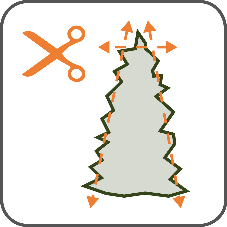
Thuja occidentalis 'Dark Embers'® is one of the easiest plants to care for in your garden. It thrives well in sunny to half-shady conditions and tolerates acidic to moderately alkine soils, which should generally be fresh to moist. Moreover, it withstands urban climates and is utterly wind-resistant.
Its tolerance in regard to planting sites and hardiness makes 'Dark Embers'® a true multitalent. Whether you plant it in a balcony box, as a solitaire or tub plant,
almost no limit can be found to the plant use. Due to its high pruning tolerance this Eastern Arborvitae is an excellent choice for slender hedges and topiary plants, as well [see pruning instructions]. Especially in autumn, the intensive dark green of the foliage creates a delightful contrast to the bright orange of the young shoots. This makes 'Dark Embers'® not just in autumn, but also the entire year, an enrichment for your garden.
With a growth height of up to 7 meters Thuja occidentalis 'Dark Embers'® is not just a perfect solitaire plant, but also a very suitable plant for hedges. The height of 7m refers to a plant in which the natural growth character is obtained. A hedge or a topiary plant can be kept at the desired growth height by regular pruning.
The natural growth of 'Dark Embers'® has a very even and compact character, which results that pruning is not necessarily needed to obtain a beautiful plant. The growth character is pyramidal upright, whereby the annual growth is about 15cm.
'Dark Embers'® is very tolerant to pruning, which allows to design your garden in many ways. Pruning is possible throughout the year, although for aesthetic reasons the ideal periods are from February to March or at the end of July. Thus the trimmed edges of the scales will quickly be overgrown by the new shoots and a more harmonious and less static appearance will be the result.
Even though Eastern Arborvitaes are very tolerant to pruning, you should not cut into the brown or woody plant parts. This applies especially to the lateral part of the plant, since they do not grow leaf scales from woody branches, anymore.
Thuja occidentalis 'Dark Embers'® is a very unpretentious plant, but it is important to avoid prolonged drought. This is even more decisive for young plants and can lead to brown leaf scales and loss of leaf scales on the inside of the plant. With a layer of mulch [e.g. bark mulch] on the ground you can reduce the drying of the soil.
When you irrigate after planting, the water needs to
infiltrate the ground till the bottom of the rootball. Within the first 1-2 years all freshly planted trees and shrubs need to be frequently irrigated. Resulting from the lack of root volume, the plants cannot buffer drought very well during this period. It is also very hard to estimate the amount of natural rainfall, so better double check the need of water by digging into the ground from time to time.
To give a general statement in regard to fertilization for your garden plant or in this case Thuja occidentalis 'Dark Embers'® is very difficult. The right supply of nutrients depends very much on the regional conditions and the ones of your garden itself. Resulting from the soil, climate and the specific nutrient conditions in your garden soil, the plant needs vary broadly.
Despite of all, sandy soils tend to have a lack of nutrients and make the necessity of fertilization more probable. On the contrary, humous, loamy or clayey soils tend to accumulate nutrients and reduce the need of fertilizers. A soil analysis, which can be ordered in internet stores or garden centers, is the safest way of analyzing your garden soil. Your garden center or online store will be able to help you with this.
An annual fertilization is recommended, at least for meager garden soils. Natural fertilizers such as horny shavings [natural long-term fertilizer] can be used, as well as artificial mineral fertilizers. Before you start fertilizing your plants, you need to make sure that the soil is moist. Otherwise the plants might get burns and the leaf scales may turn brown [due to high salt concentrations in the soil].
Especially artificial fertilizers need to be spread carefully over the ground and no fertilizer grains should remain on the needles or branches of the plant. Both could lead to plant burns. Preferably, the best time for the use fertilizers is spring, while they can be applied approximately from April to the end of July.





